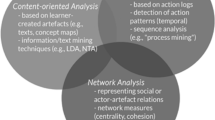Abstract
Micro-scaffolding is an important local phenomenon on a micro-scale of teacher-student-interactions. However, the idea of supporting students to move forward in their zones of proximal developments requires a sound global conceptualization of the intended learning trajectories. This article focuses on the trajectories towards percentages, and investigate how micro-scaffolding depends on aligning students’ learning pathways to these intended learning trajectories (designed in macro-scaffolding). A qualitative study was conducted in a series of design experiments. In the process of analyzing 590 min of rich video data with respect to the interplay between micro-and macro-scaffolding, a new analytic procedure, trace analysis, is developed and applied to the analysis. One central outcome of this study is the relevance of a key characteristic of effective micro-scaffolding, namely reference to a hypothetical learning trajectory as macro-orientation.








Similar content being viewed by others
References
Confrey, J. (2006). The evolution of design studies as methodology. In K. Sawyer (Ed.), Cambridge handbook of the learning sciences (pp. 135–152). Cambridge: Cambridge University Press.
Cummins, J. (2000). Language, power and pedagogy. Clevedon: Multilingual Matters.
Freudenthal, H. (1983). Didactical phenomenology of mathematical structures. Dordrecht: Reidel.
Gibbons, P. (2002). Scaffolding language, scaffolding learning. Teaching second language learners in the mainstream classroom. Portsmouth: Heinemann.
Gravemeijer, K. (1998). Developmental research as a research method. In J. Kilpatrick & A. Sierpinska (Eds.), What is research in mathematics education and what are its results? (pp. 277–295). Dordrecht: Kluwer.
Gravemeijer, K., & Cobb, P. (2006). Design research from a learning design perspective. In J. V. D. Akker, K. Gravemeijer, S. McKenney, & N. Nieveen (Eds.), Educational design research (pp. 17–51). London: Routledge.
Hammond, J., & Gibbons, P. (2005). putting scaffolding to work: the contribution of scaffolding in articulating ESL education. Prospect An Australian Journal of TESOL, 20(1), 6–30.
Kouba, V., Brown, C., Carpenter, T., Lindquist, M., Silver, E., & Swafford, J. (1988). Results of 4th NAEP assessment of mathematics. Arithmetic Teacher, 35(8), 14–19.
Lajoie, S. (2005). Extending the scaffolding metaphor. Instructional Science, 33(5–6), 541–557.
Lamon, S. J. (2007). Rational numbers and proportional reasoning. In F. K. Lester (Ed.), Second handbook of research on mathematic teaching and learning (pp. 629–667). New York: Macmillan.
Morgan, C., Craig, T., Schuette, M., & Wagner, D. (2014). Language and communication in mathematics education: an overview of research in the field. ZDM – The International Journal on Mathematics Education, 46(6), 843–853.
Parker, M., & Leinhardt, G. (1995). Percent: a privileged proportion. Review of Educational Research, 65(4), 421–481.
Pimm, D. (1987). Speaking mathematically. London: Routledge.
Pöhler, B. & Prediger, S. (2015). Intertwining lexical and conceptual learning trajectories—A design research study on macro-scaffolding towards percentages. Eurasia Journal of Mathematics, Science & Technology Education, 11(6), 1697–1722.
Pöhler, B., Prediger, S., & Weinert, H. (2015, in press). Cracking percent problems in different formats—the role of texts and visual models for students with low and high language proficiency. In: Proceedings of CERME 9, Prague.
Prediger, S., & Wessel, L. (2013). Fostering German language learners’ constructions of meanings for fractions—design and effects of a language- and mathematics-integrated intervention. Mathematics Education Research Journal, 25(3), 435–456.
Puntambekar, S., & Kolodner, J. L. (1998). Distributed scaffolding: helping students learning by design. In A. S. Bruckman, M. Guzdial, J. L. Kolodner, & A. Ram (Eds.), Proceedings of the third international conference of the learning sciences (ICLS’98) (pp. 35–41). Atlanta: Association for the Advancement of Computing in Education.
Reiser, B. J., & Tabak, I. (2014). Scaffolding. In R. K. Sawyer (Ed.), The Cambridge handbook of the learning sciences (pp. 44–62). Cambridge: Cambridge University Press.
Schleppegrell, M. J. (2004). The language of schooling: A functional linguistics perspective. Mahwah: Lawrence Erlbaum.
Smit, J. (2013). Scaffolding language in multilingual mathematics classrooms. PhD-Thesis, Utrecht: Freudenthal Institute.
Smit, J., van Eerde, H. A. A., & Bakker, A. (2013). A conceptualisation of whole-class scaffolding. British Educational Research Journal, 39(5), 817–834.
Tabak, I. (2004). A complement to emerging patterns of distributed scaffolding. The Journal of the Learning Sciences, 13(3), 305–335.
Van de Pol, J., Volman, M., & Beishuizen, J. (2010). Scaffolding in teacher–student interaction: a decade of research. Educational Psychology Review, 22(3), 271–296.
Van den Heuvel-Panhuizen, M. (2003). The didactical use of models in realistic mathematics education. Educational Studies in Mathematics, 54(1), 9–35.
Wessel, L. (2015). Fach- und sprachintegrierte Förderung durch Darstellungsvernetzung und Scaffolding. Heidelberg: Springer Spektrum.
Wood, D. J., Bruner, J. S., & Ross, G. (1976). The role of tutoring in problem solving. Journal of Child Psychiatry and Psychology, 17(2), 89–100.
Author information
Authors and Affiliations
Corresponding author
Rights and permissions
About this article
Cite this article
Prediger, S., Pöhler, B. The interplay of micro- and macro-scaffolding: an empirical reconstruction for the case of an intervention on percentages. ZDM Mathematics Education 47, 1179–1194 (2015). https://doi.org/10.1007/s11858-015-0723-2
Accepted:
Published:
Issue Date:
DOI: https://doi.org/10.1007/s11858-015-0723-2




